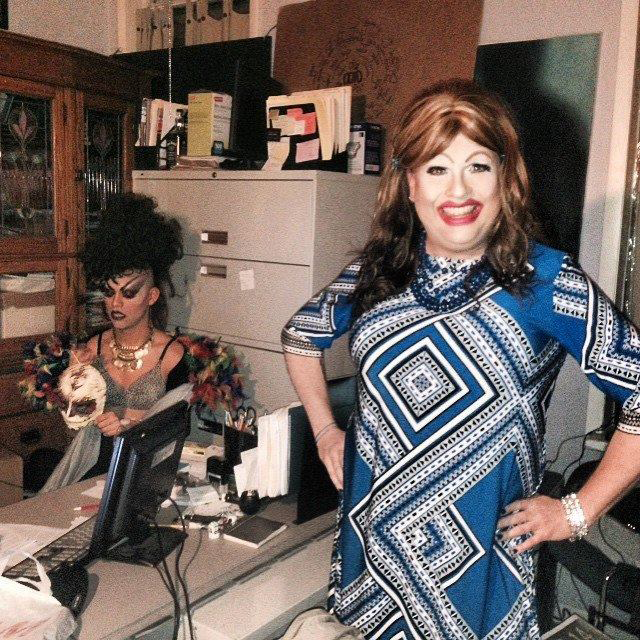The show starts a little late, but that’s part of the charm—drag queens are never on time. Cultura in Pilsen does not normally host drag shows, but it is hosting one tonight. While waiting, the clientele sips PBR and obscure German pilsner, speaking in Spanish, English, and Spanglish about the décor. The walls feature Día de los Muertos paintings: one is a black and white print of the Chiquita logo with a skeletonized Chiquita Banana lady. The piece distracts me long enough for the drag show to begin, and I write it off as a cute, seasonal Chiquita ad campaign.
Cultura houses contratiempo and Gozamos, two organizations dedicated to enhancing bilingual cultural activity in Chicago. The space hosts a diverse array of events, from workshops and concerts to—apparently—the occasional drag show.
Tonight’s drag show, “Lola von Miramar presents Abolition of the Duck: A Literary Drag Cabaret,” is bilingual. The show will feature three drag queens: the aforementioned Lola von Miramar (Larry La Fountain-Stokes), Horchata La Tata (Brian Antonio Garcia) and Jezebel À GoGo (Jeremy Saxon).
Moira Pujols, the executive director of contratiempo, introduces the show. This is Lola’s first time performing in Chicago, but she’s performed in New York, Ann Arbor, Buenos Aires, Mexico, Montreal, and San Juan. If Ann Arbor sticks out, it should—Lola is based in Ann Arbor, where she is a professor in Latino/a Studies and Spanish. Or rather, Lola’s dear friend Larry La Fountain-Stokes is a professor in Latino/a Studies and Spanish. Pujols explains that there will be a book signing of Abolición del pato (Abolition of the Duck) after the show: “Lola von Miramar will be signing books for her best friend, Larry La Fontaine.”
After this introduction, Lola rushes the stage, purse in hand. She’s in high-camp drag: a blue and white geometric dress, with makeup done for the back row. As she settles on stage she makes more jokes about her best friend Larry. After, she lip-syncs Carmen Miranda’s “South American Way,” a bilingual song. She’s goofy, a lot of fun. When she finishes, she invites up the next performer, Horchata La Tata.
Horchata comes to the stage wearing a mask that Lola later steals and starts wearing herself. Underneath the mask, Horchata has painted on severe eye makeup that seems to go all the way to her temples. Straddled by the edges of her eye makeup is a giant, curly fauxhawk wig. The whole look is topped off by a plume of feathers that wraps around her back. Horchata slays a lip-sync performance before reciting a slam-style narrative of her complicated relationship with her mother. After, Jezebel À GoGo saunters onto the stage. She’s dressed as the Statue of Liberty, clutching a makeshift torch which she later refers to as a dildo. Jezebel walks slowly, commanding the respect that the Statue of Liberty deserves. She launches into her story of immigrating to America from Panama and fighting to fit in.
Both of the performances are emotionally heavy, but drag gags such as Jezebel removing two cans of Coke from her breasts keep the evening light. Lola walks a similarly fine line during a reading from Abolición del pato after Jezebel’s performance. As Lola explains, “In Puerto Rico, duck is a stigmatized term used to talk about homosexuality.” The book is about the intimate relationship between drag, cross-dressing, and activism in Puerto Rico. While reading, Lola comments on the frequency of hate crimes against gay people in and outside Puerto Rico: “One hundred and fifty years. You’d think that’d be sufficient time to, you know, not kill people.” For Lola, drag performance in Puerto Rico is not just about resisting prescribed gender, but also a way to comment on the complicated race relations and political situation on the American island territory.
Just as she starts to get heavy again, she stops the reading and lets the music play. Horchata La Tata and Jezebel À GoGo return to the stage, and Lola orders the whole room to dance along. At first, a lot of people just stand and sway a little. This changes when the drag queens start commanding people to move and dragging people into salsa dances. By the end of the song, the entire room is giggling and dancing, and some are even buying books, all because a drag queen told them to.
I walk out of Cultura discussing the merits of the drag queens, talking about gay rights, and translating parts of the evening for friends. It’s not until a while after my night with Lola and friends that I Google the skeletal Chiquita Banana lady that hung in the corner of the room.
I find the same image in an article written by Elvin Yavuz and published by Gozamos, one of the organizations housed in Cultura. It was not a special Día de los Muertos Chiquita Banana advertisement campaign. It was a piece by Nicaraguan artist Carlos Barberena designed to protest controversial farming practices by Chiquita—they use a toxin when farming that is harmful to the environment. Hidden in plain sight underneath the mass-produced, iconic images of capitalism, the political messages in Barberena’s art remind me of the subversion hidden in those men in dresses with goofy senses of humor, fierce make-up skills, and Cokes for breasts.

